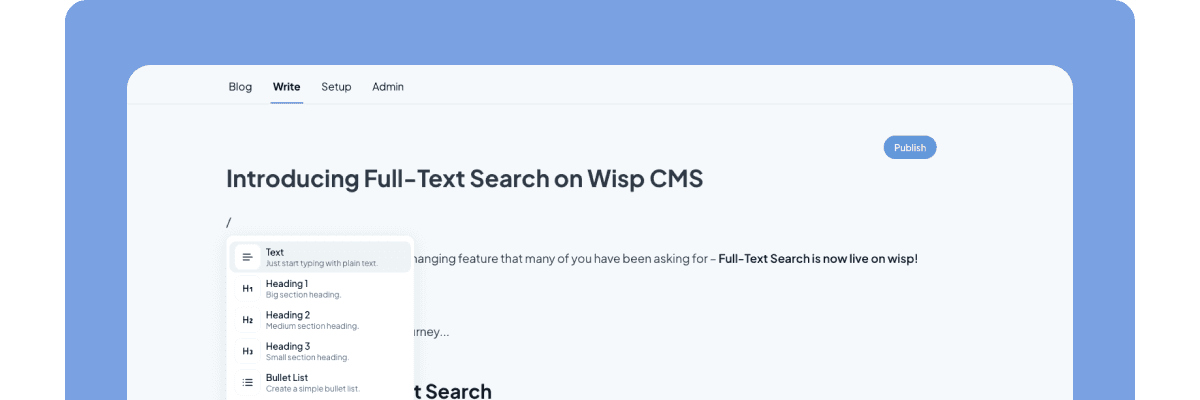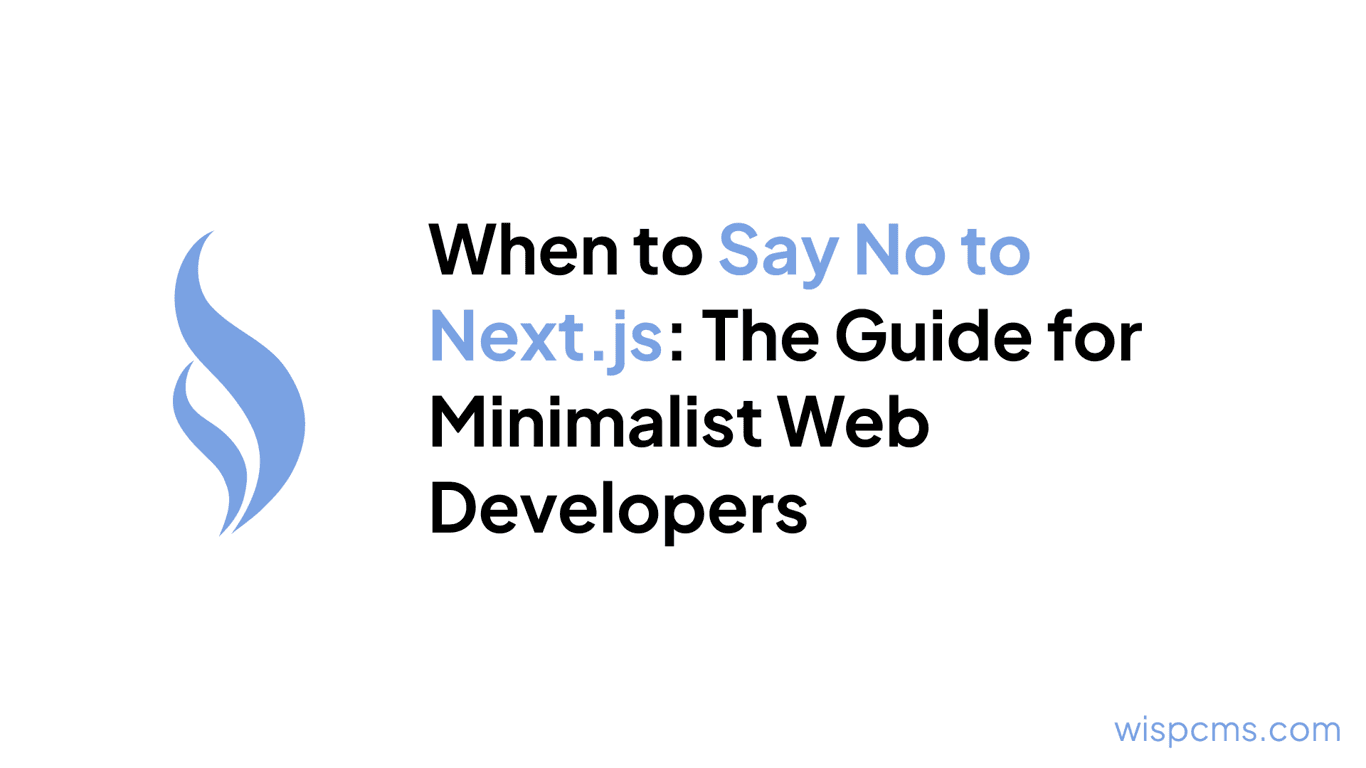 You've invested time learning Next.js, built projects with it, and enjoyed its server-side rendering capabilities. But lately, development feels like wading through mud. Your build times are painfully slow, server functions don't work in parallel, and you find yourself mixing different techniques just to get things working. When you make a simple server-side change, you're forced to wait for the entire frontend to rebuild.
You've invested time learning Next.js, built projects with it, and enjoyed its server-side rendering capabilities. But lately, development feels like wading through mud. Your build times are painfully slow, server functions don't work in parallel, and you find yourself mixing different techniques just to get things working. When you make a simple server-side change, you're forced to wait for the entire frontend to rebuild.
Sound familiar? You're not alone.
While Next.js remains a popular React framework with impressive features, many developers are hitting roadblocks that impact productivity and architecture decisions. Let's explore why you might want to consider alternatives to Next.js and what options exist for different project needs.
The Growing Pains of Next.js Development
Complexity That Scales With Your Project
Next.js starts simple but gradually introduces complexity that becomes difficult to manage. As one developer put it:
"The usual pain points, fundamental reason behind it being complexity of RSC and unmodular architecture with 'God level' build process that has to know every detail of entire app to work."
This "God level" build process creates a system where changes in one area necessitate rebuilding large portions of your application. The React Server Components (RSC) implementation, while powerful, adds layers of complexity that can be challenging to debug and optimize.
Development Speed That Tests Your Patience
Perhaps the most common complaint revolves around development speed. The painfully slow development experience drives many developers away from Next.js:
"The painfully slow development experience was what caused me to move away."
When you're in a productive flow state, waiting for rebuilds after minor changes can be incredibly frustrating. This slowdown is particularly noticeable when making server-side changes, as one developer explains:
"I still separate the backend. When I am developing, I don't want to make a change server-side and have to wait for the frontend to rebuild."
Limitations for Full-Stack Applications
Next.js positions itself as a full-stack framework, but many developers find it has significant limitations when building comprehensive applications:
"For a full stack app it has many limitations and recently I started to explore TanStack Start, I've worked in the past with React Router and it seems promising."
These limitations often manifest when trying to build complex backend functionality or when integrating with specific libraries. One developer shared their frustration with Next.js and Three.js compatibility:
"After ruining a perfect weekend with Next/ThreeJs incompatibility, I'm over edge as well."
The Vercel Dependency Concern
Next.js is developed by Vercel, and while it's technically open-source, there's a growing concern about the tight coupling between the framework and Vercel's platform:
"The way Vercel tightly couples NextJS with its own architecture is disappointing."
This vendor lock-in concern makes some developers hesitant about building large-scale projects on Next.js, especially if they prefer flexibility in deployment options or are working in environments where Vercel isn't the optimal hosting solution.
Internationalization Headaches
If your application needs to support multiple languages, Next.js might present additional challenges:
"Next.js is still a pain for all localized pages structure and localized slugs. Pretty great if you don't need i18n."
Managing localized content, routing, and SEO optimization across multiple languages often requires workarounds and custom solutions that add to the overall complexity.
Real-world Challenges With Next.js Server Functions
One of the most practical issues developers face is the limitation with server functions. As one developer explains:
"Not being able to do parallel server functions make them useless for queries so you also end up with a mix of techniques. If you want the end to end types you end up with tRPC or something like that and you may as well use that for everything."
This leads to an inconsistent approach where you might use Next.js server functions for some tasks but need to implement alternatives like tRPC for others. The result is often a fragmented codebase with multiple paradigms for handling server-side logic.
Once you start using libraries like TanStack Query (formerly React Query) alongside Next.js, you're essentially maintaining parallel caching systems, which further adds to the complexity:
"You're in tanstack query anyway at that point and now your cacheing is spread across that and next."
Compelling Alternatives to Consider
If these pain points resonate with you, it might be time to explore alternative frameworks that better align with your specific needs. Here are some strong contenders:
Astro: For Content-Heavy Static Sites
 If your project is primarily content-focused, Astro offers a compelling alternative:
If your project is primarily content-focused, Astro offers a compelling alternative:
"Astro is great for content heavy static site. Easily achieve 95+ performance on mobile."
Astro's key advantage is its "zero JavaScript by default" approach, where it only sends JavaScript necessary for interactivity. This results in blazing-fast static sites with minimal client-side overhead. For blogs, documentation, and marketing sites, Astro can deliver superior performance with a simpler development model.
Remix: For Interactive Web Applications

Remix focuses on fast, interactive applications with rich routing capabilities. Its nested routing system and built-in data loading patterns create a more cohesive developer experience. Remix also emphasizes progressive enhancement, making it suitable for applications that need to work across varying network conditions.
TanStack Router + React: For Maximum Flexibility
For developers who want complete control over their stack, combining React with TanStack Router (formerly React Router) provides flexibility without the overhead of a full framework:
"I've worked in the past with React Router and it seems promising."
This approach lets you build your application architecture piece by piece, choosing the exact tools you need without the constraints of a monolithic framework. While it requires more initial setup, it can lead to a more tailored development experience.
Gatsby: For Static Sites with Rich Features

Gatsby remains a strong contender for static sites that need rich features. Its extensive plugin ecosystem and GraphQL data layer make it particularly well-suited for projects that pull data from diverse sources. Like Next.js, Gatsby offers image optimization and performance enhancements out of the box, but with a focus on static site generation.
Making the Transition: Practical Steps
If you're considering moving away from Next.js, here's a practical approach:
Evaluate your specific pain points: Identify exactly what aspects of Next.js are causing friction in your development process.
Consider your application type: Content-heavy static sites might benefit from Astro or Gatsby, while interactive applications might be better suited for Remix or a custom React setup.
Start with a small project: Test your chosen alternative with a smaller project before committing to a full migration.
Separate frontend and backend concerns: Regardless of which frontend framework you choose, consider separating your backend services for improved development speed and flexibility.
Leverage existing knowledge: Many alternatives still use React, so your component knowledge remains valuable even as you transition to a different framework.
Conclusion: It's About Finding the Right Tool
Next.js isn't inherently bad—it's simply not the right tool for every job. As your projects evolve and your needs change, it's natural to outgrow certain technologies.
By understanding the limitations of Next.js and exploring alternatives like Astro, Remix, or custom React setups, you can find a development environment that better aligns with your specific requirements. The ideal framework is the one that gets out of your way and lets you focus on building great user experiences without unnecessary complexity or performance bottlenecks.
Remember that the JavaScript ecosystem continues to evolve rapidly. The frameworks mentioned here will themselves evolve or be replaced by new approaches. The key is to stay adaptable and choose tools that solve your specific problems rather than conforming to whatever happens to be most popular at the moment.
Your development experience matters. If Next.js is slowing you down or adding unnecessary complexity, it might be time to move on to greener pastures.



